War Memorial Hall c1929

John GOULD - TAYLOR
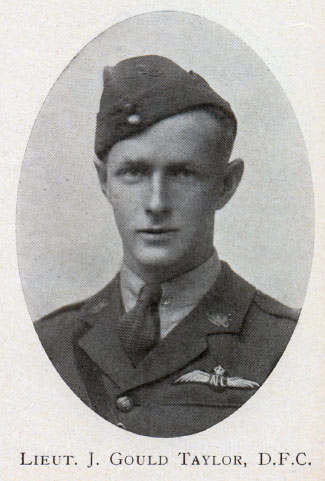
John ‘Jack’ Gould-Taylor was born on 15 June 1897 in Young, at The Retreat, New South Wales. His parents were the Rev. William and Marion (née Paterson) Gould-Taylor. He attended Scotch from 1913 to 1915. He was in the winning 1915 Athletics team. He came first in the school open handicap in 120 yards hurdles and 2nd at 100 yards.
John was a university student when he enlisted on 18 September 1916 at Melbourne, Victoria. He served in the No. 3 Squadron Australian Flying Corps with the rank of Lieutenant. His Regimental Number was 30589.
Jack died on 3 October 1918 at Estrees, France. He was 21 years of age.
Service record
Jack Gould-Taylor was a student at Scotch College when the war began. He enlisted in the AIF in September 1916, at the age of 19. His mother gave consent for her only son to enlist (see below). His father, a Presbyterian minister, had died in 1905. Jack was initially allotted to Field Artillery Reinforcements at Maribyrnong. On 1 November he became a Driver with the 22nd Reinforcements to the 1st Divisional Ammunition Column, and embarked with them from Melbourne on 23 November 1916. More than a month later, on 29 January 1917, they disembarked at Plymouth, England. In April 1917 he was hospitalised with mumps for some 19 days.
On 1 August he was transferred to the Australian Flying Corps. On 30 November 1917, having graduated as a pilot he was appointed Flying Officer (Pilot) - apparently equivalent to 2nd Lieutenant - and became a full Lieutenant in the Australian Flying Corps on 28 February 1918. In March 1918 he seems to have been at an Artillery and Infantry Co-operation School in England, and on 9 March to have proceeded overseas to join No. 3 Squadron of the Australian Flying Corps. He arrived in France on 10 March. In June he had two weeks leave. In July 1918 he went to hospital sick with tonsilitis. He was away for eight days. He was sent to the Officers’ Rest House RAF for nine days from 16-25 July.
Jack’s service file contains a document sent from Australian Base Records to his mother in May 1919 accompanying a Royal Air Force order of 13 September 1918 which referred ‘in laudatory manner to the conspicuous manner in which your son… conducted himself in the face of the enemy.’ (see below). Perhaps this related to his actions on 28 August, which would lead to him receiving a Distinguished Flying Cross. His recommendation showed that while flying a reconnaissance mission that day he was attacked by five Fokker biplanes but managed, ‘with characteristic boldness and skill’, to drive them off. He then completed the mission, calling down artillery fire successfully on enemy artillery and transport. This was said to be typical, as was a desire to attack whenever he could.
On 3 October he did not return from a 6 a.m. artillery patrol. His Commanding Officer explained later that there was a report that a shell had struck an aeroplane in flight, but no aeroplane could be found until 6 October 1918 (See below). Then Jack’s crashed aircraft, an R.E.8 was found on Folemprise Farm, 1000 yards north-west of Estrees, with no damage to suggest how it had come down. Jack and his observer, Lieutenant Bruce Thomson, had been buried next to the aircraft. A Corporal McCarty of the same squadron saw the aircraft leave the ground on 3 October, and heard about their deaths and burial (see below). Jack’s DFC was only announced in the London Gazette on 2nd November 1918.
Jack clearly remained attached to Scotch after enlisting. The 1918 Scotch Collegian mentions that fellow Old Collegian Gunner L.L. (Lance ‘Tich’) Adams, with whom he had attended Scotch and since met in England, was in the front line in France when he received a letter that John Gould-Taylor dropped from his aircraft. To the letter were supposedly attached the colours cardinal, gold and blue. The article concluded “Scotch forever” (see below). In 1919 an obituary appeared, which said: ‘Letters to hand recently state “Jack and his observer were killed in action on Ocotber 3rd, 1918. It is believed that they were shot down at 800 feet while on the dawn contact patrol. Their bodies were found later by men of the 21st Battalion, who buried them at Estrees, near St Quentin. When the squadron came to the spot they erected crosses made of the broken propellors."' The piece concluded that ‘Jack had a great love, and was a fine battler, for his old School. His machine gun carried a small Scotch flag when it fell.’
John Gould-Taylor is buried in the Prospect Hill Cemetery (Plot III, Row A, Grave No. 12), Gouy, France.
Photographs and Documents:
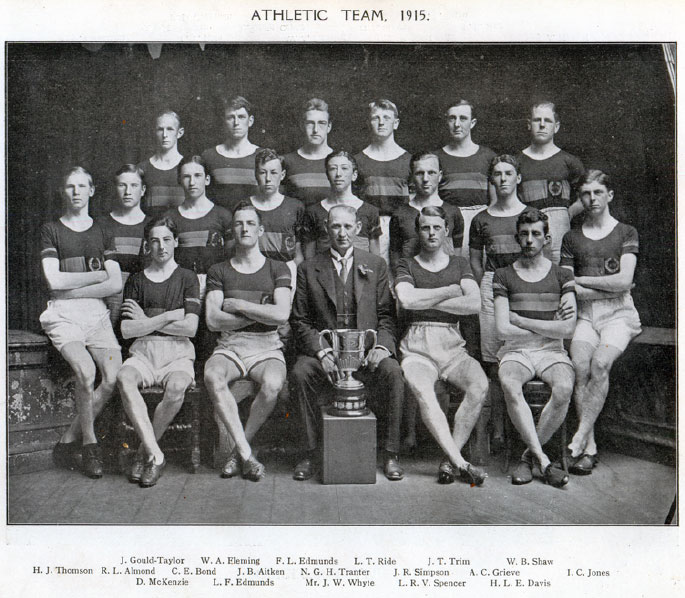
Jack Gould-Taylor is at far left in the back row of this photograph of the victorious 1915 Scotch Athletics team. Jack Trim, further along in that row, would also be killed in 1918.
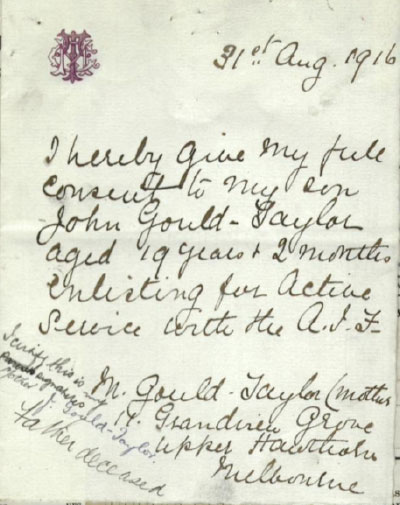
Jack’s mother gives permission for him to enlist in the AIF.
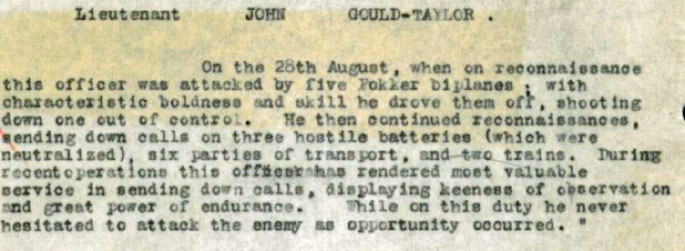
The recommendation for John Gould-Taylor’s Distinguished Flying Cross.
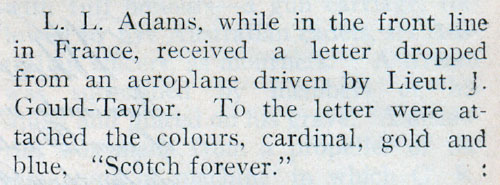
L.L. Adams reports on Gould-Taylor’s letter with a Scotch connection.
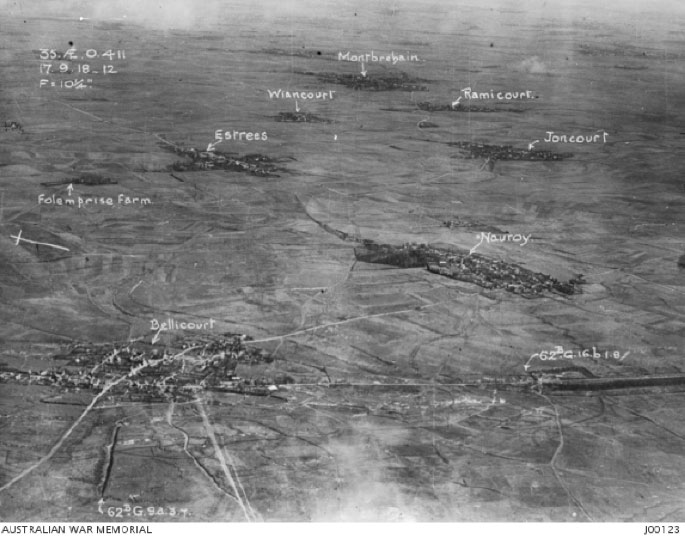
Jack Gould-Taylor was said to have been killed at Folemprise Farm, pictured above from an aerial photograph taken, perhaps by him, on 17 September 1918, just 16 days before his death. Stan Neale was killed near Bellicourt in the interval.
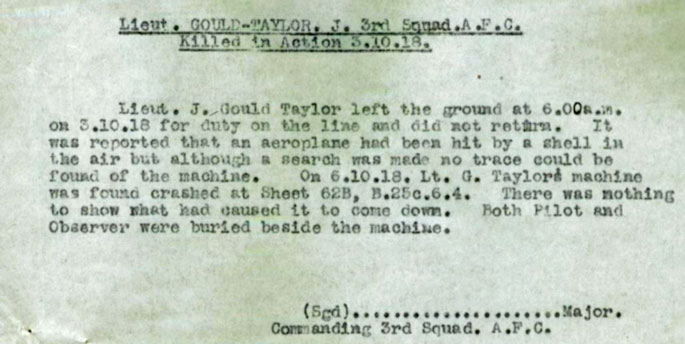
The commanding officer of the 3rd Squadron explains the circumstances of Jack’s death
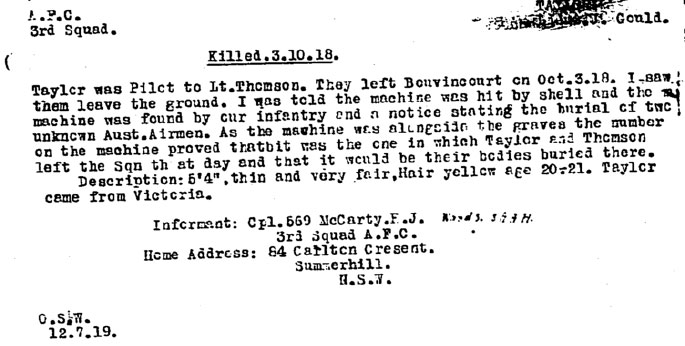
Corporal McCArty’s account of Jack’s final hours. His description of Jack’s height underestimates it by 3½ inches.
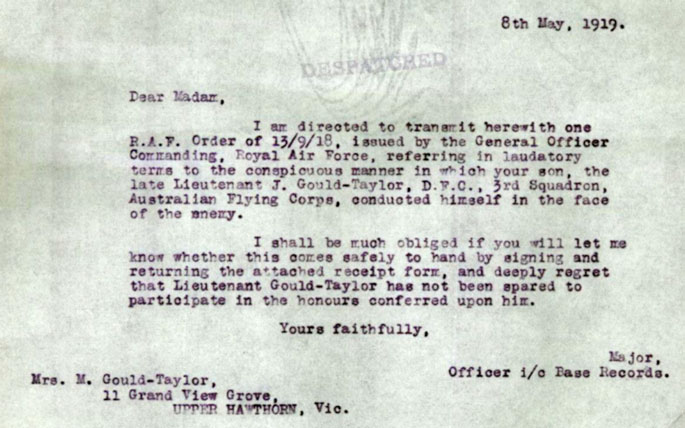
Letter to Jack’s mother passing on the Royal Air Force’s praise of his efforts. Unfortunately the RAF Order is not in Jack’s service file.
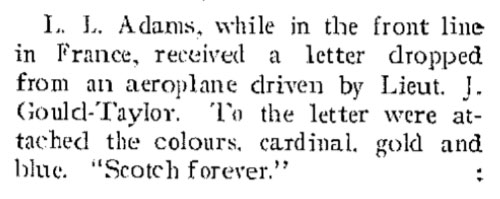
From the 1918 Scotch Collegian.
Sources:
- Australian War Memorial – Roll of Honour and Red Cross Wounded and Missing file
- Mishura Scotch Database
- National Archives of Australia – B2455, GOULD-TAYLOR J
- Scotch Collegian 1915, 1918, 1919
- The AIF Project - https://www.aif.adfa.edu.au/showPerson?pid=115296


